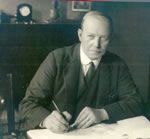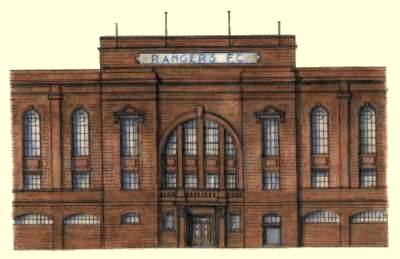But there is one place where Archibald Leitch's work is most fondly remembered and cherished . For that is where his finest work still stands today, that place is where The Rangers call home - Ibrox Stadium.
Archibald Leitch was born on April 27th 1865. In Comleypark Street, Camlachie, Glasgow. The area was a heavy industrial site. At this time Glasgow had earned the title of Second city of the Empire. His father, a blacksmith, would have had little problem finding work. Factories of every description churned out goods that would be loaded onto ships and transported all over the world. It is worth remembering that the total tonnage of the British merchant fleet at this time was greater than the rest of the world put together.
For a bright boy opportunities were there to be had. Fortunately, Archie was bright and he won a place at grammar school. From there he attended Anderson's College where he studied science. When Archie was still at school he would have had to walk past or through Glasgow Green every day. He may of even watched some youths playing football there in 1872?

After he graduated, Archie was employed by Ducan Stewart and Company as a Draftsman. In 1887 he went to sea as a marine engineer and when he returned in 1899 he was given his old job back. Within a few months he was head of the ordering department of Mirlees Watson and Company. Coincidently the company was situated in Kinning Park where the youths from Glasgow Green were now taking things a bit more serious.
In 1896 Archie decided the time was right to enter business for himself. His headed note paper displayed 'Archibald Leitch Factory Architect and Consulting Engineer'. He designed factories, had contracts with local authorities and seemed to be doing quiet well for himself.
In March 1899 Archie received the call from The Rangers where he was commissioned to build Ibrox Park, the new home ground. Leitch's stadiums were initially considered functional rather than aesthetically elegant, and were clearly influenced by his early work on industrial buildings. Typically, his stands had two tiers, with criss-crossed steel balustrades at the front of the upper tier, and were covered by a series of pitched roofs, built so that their ends faced onto the playing field; the central roof span would be distinctly larger, and would incorporate a distinctive pediment.

His first project in England was the design and building of the John Street Stand at Bramall Lane, which provided 3,000 seats and terracing for 6,000 and was dominated by a large mock-Tudor press box.
Even after the Ibrox disaster of 1902, when 26 people were killed when a bank of terracing collapsed, Leitch was still in demand. Over the next four decades he became Britain's foremost football architect, and he was commissioned to design part or all of over 20 major stadiums, including:
- Anfield, Liverpool
- Ayresome Park, Middlesbrough
- Bramall Lane, Sheffield
- Cardiff Arms Park, Cardiff
- Celtic Park, Glasgow
- Craven Cottage, London
- The Den, London
- The Dell, Southampton
- Ewood Park, Blackburn
- Fratton Park, Portsmouth
- Goodison Park, Liverpool
- Hampden Park, Glasgow
- Home Park, Plymouth
- Ibrox Park, Glasgow
- Highbury, London
- Bramall Lane, Sheffield
- Hillsborough Stadium, Sheffield
- Lansdowne Road, Dublin
- Leeds Road, Huddersfield
- Maine Road, Manchester
- Molineux,Wolverhampton
- Old Trafford, Manchester
- Roker Park, Sunderland
- Selhurst Park, London
- Stamford Bridge, London
- Starks Park, Kirkcaldy
- Twickenham Stadium, London
- Tynecastle Stadium, Edinburgh
- Villa Park, Birmingham
- West Ham Stadium, East London
- White Hart Lane, London
- Windsor Park, Belfast
Many of his works have since been demolished for redevelopment (especially in wake of the Taylor Report and the move to all-seater stadiums), most notably the Trinity Road Stand at Villa Park, considered one of his best works, which was demolished in 2000. The main stand and pavilion at Craven Cottage, and the façade of the Main Stand at Ibrox (although the stand itself has been remodelled) still survive to this day; both are now listed buildings.
Recommended Reading
Inglis, Simon (2005). 'Engineering Archie: Archibald Leitch - Football Ground Designer'. English Heritage. ISBN 1-85074-918-3.
Discuss this article
Enjoyed this article? Disagree entirely? Found a spelling mistake? Whatever your opinion, it's welcome on our popular and friendly message-board.











